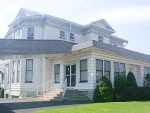Aging building rich in local history

Editor's note: the building at the corner of Ash and Austin in Nevada has a long and interesting history, having been home to the Weltmer Institute (an 'alternative healing' facility), then Milster Funeral Home for many years, will soon be replaced by a video rental store, if plans currently before the city council are approved. Daily Mail/Herald columnist Kelly Bradham reports that "a lot of folks are talking about it, and they don't like it. It's a historic building. It ought to be on the Historic Register. That's an important part of the area's hstory." Following is a brief overview of the Weltmer Institute.
By Steve Moyer
Nevada Daily Mail
Healer, psychologist, psychic researcher and preacher; charlatan, fraud, hoax, and humbug all have been used to describe Sidney A. Weltmer. Lauded by many who gave glowing testimonials of his treatments Weltmer was also hated and reviled by many.
Branded a fraud by the United States Postmaster General in 1900 Weltmer fought back in the courts and won a decision in the United States Supreme Court that kept the Weltmer Institute alive and well, at least as long as Weltmer himself lived.
Weltmer arrived in Nevada in 1897 already practicing his unique brand of medicine and purchased the building that housed his practice on the corner of Ash and Austin. In three short years his practice had attracted adherents from all over the country and the railroad had to add trains to the schedule to handle all of the traffic generated by this single business.
Weltmer's blend of psychology, some of Weltmer's practices anticipated Freud's, and belief in the power of God to heal angered both doctors and preachers. Dr. Preston W. Pope printed a treatise "The Expose of Weltmerism: Magnetic Healing De-magnetized" and Dr. E. L. Priest gave a speech to the Missouri Medical Association denouncing Weltmer. Reverend Dr. Charles M. Bishop, pastor of Centenary Methodist Church, gave a sermon that was later printed in a St. Louis based magazine the Christian Advocate. In the sermon Bishop called magnetic healers "miserable charlatans" and branded Weltmerism "an ignorant mixture of Voodoo and Christian Science".
Weltmer and his business partner filed suit in Butler asking for $20,000 in damages. During the trial the crowd was so great the proceedings had to be moved -- as it happened, right next to a saloon. Accusations were soon made that Weltmer was buying drinks for the jurors hoping to influence their decision. An investigation was conducted and it was discovered that the Methodist magazine was the one purchasing the drinks.
Weltmer won a $750 judgment but his troubles weren't over yet. In May 1900 the U.S. postmaster general imposed a stop order on all of the institutes mail. Weltmer had devised a method of healing by mail and the postmaster general declared it a fraud. Mail was returned to the senders until Weltmer arranged to pick up all mail at the post office in person.
Weltmer filed suit against the local postmaster to resolve the issue and the resulting case went all the way to the U.S. Supreme Court which decided in Weltmer's favor.
Ironically, the volume of mail generated by the Weltmer Institute was so great the post office was upgraded and a new building erected to handle the flow.
With both cases settled in 1902 there was nothing to keep Weltmer from continuing his practice, and he did.
In 1907, Weltmer began a series of experiments in psychic research involving hundreds of people over a three-year period.
A committee would come up with a message and hand it to Weltmer just before the experiment would start each day.
The messages were simple, "I'm thinking of a rose" or similar thought.
People involved in trying to receive the thought would write their impressions down and they would be compared with what Weltmer sent.
Although intrigued by the results, Weltmer eventually gave up on psychic research and it wasn't until the 1930s that anyone would attempt such a large experiment again.
Weltmer also was involved in the "New Thought" movement and was a speaker at the second international conference of the movement in 1916. One of the principles of the New Thought movement, which Weltmer also believed, was adopted at the first conference a year earlier.
"We affirm the Good. This is supreme, universal and everlasting. Man is made in the image of the Good, and evil and pain are but the tests and correctives that appear when his thought does not reflect the full glory of this image."
The Weltmer Institute flourished until 1930 when Sidney A. Weltmer died.
His family tried to carry on the institute but in a very real way Weltmer was the institute and without him the institute closed and the building was eventually sold to a mortician and became a funeral home.
